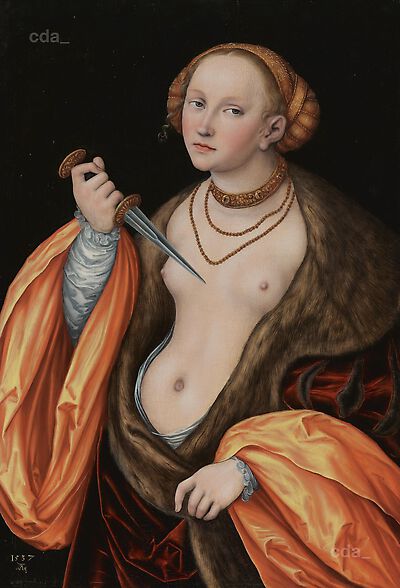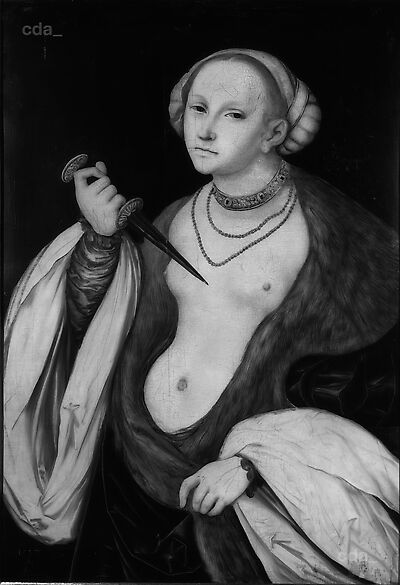Lucretia points the raised dagger at herself and is about to commit suicide. Despite the fact that this mortal sin was perpetrated by a heathen the subject was very popular at the Wittenberg court and numbered among the so-called 'Roman virtues' (Römertugenden). Lucretia's story is part of the Roman Republic's
Lucretia points the raised dagger at herself and is about to commit suicide. Despite the fact that this mortal sin was perpetrated by a heathen the subject was very popular at the Wittenberg court and numbered among the so-called 'Roman virtues' (Römertugenden). Lucretia's story is part of the Roman Republic's foundation myth and was at the same time a moral lesson: Lucretia who was married virtuously resisted the advances of the Roman King's son Sextus Tarquinius, who then raped her. After the deed Lucretia had her father and husband vow vengeance and then she stabbed herself. The event led to an uprising in which the royal family was overthrown and the Roman Empire became a Republic. The viewer is thus reminded, that only a virtuous and Christian ruler can guarantee the continuity of his kingdom. The dynasty of a tyrant will fall. The manner in which the naked figure of Lucretia is represented and the associated erotic appeal conflicts with the moral exemplum depicted. Cranach plays with these opposites and resolves the conflict in favour of virtue by showing Lucretia at the very moment she slays her coveted body.
[Herrschaft, Exhib. Cat. Düsseldorf 2017, 242, No. 143]
- Attributions
-
Lucas Cranach the Elder
Lucas Cranach the Younger
Attributions
| Lucas Cranach the Elder | [Friedländer, Rosenberg 1979, 118, No. 240P] |
| Lucas Cranach the Younger | 'Lucas Cranach the Elder and Lucas Cranach the Younger' [Auct.Cat. Sotheby's New York in the Archive D. Koepplin, 2009] |
- Production date
- 1537
Production date
| 1537 | [dated] |
- Dimensions
- Maße Bildträger: 86,9 x 57,9 cm
Dimensions
Maße Bildträger: 86,9 x 57,9 cm
[Ausschnitt Aukt.Kat. Sotheby's New York im Archiv D. Koepplin, 2009]
Dimensions of support: 86.9 x 57.9 cm
[Auct.Cat. Sotheby's New York in the Archive D. Koepplin, 2009]
- Signature / Dating
Artist's insignia at the lower left: serpent (with dropped wings) and dated '1537'
Signature / Dating
Artist's insignia at the lower left: serpent (with dropped wings) and dated '1537'
- Owner
- Private Collection
- Repository
- Private Collection
- CDA ID
- PRIVATE_NONE-P159
- FR (1978) Nr.
- FR240P
- Persistent Link
- https://lucascranach.org/en/PRIVATE_NONE-P159/

